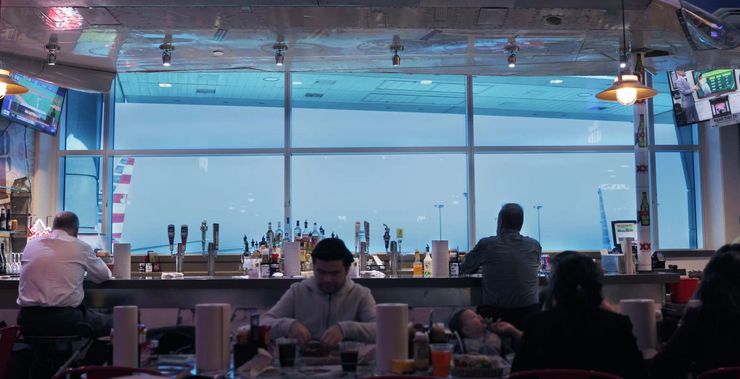smart glass/ electrochromatic glass: windows with technology sandwiched between two plates of glass with electrical power and Internet connections that can be programmed to adjust sunlight conditions to reduce heat and glare.
*** TROVELOG ***
The tinted world of tomorrow is coming, and airports—mini-cities of steel, concrete and lots and lots of glass—are interested. In a test last fall, Dallas-Fort Worth International Airport outfitted one of its gates with a new type of “smart glass” that can adjust for sunlight exposure. The obvious point is to keep travelers from getting overheated—but the exercise also brought a more lucrative benefit.
. . .
It turns out that a cooler, darker bar encourages an extra round or two. Alcohol sales soared 80 percent in October, compared with the same period in 2016, the installation of electrochromatic glass being the only difference. Alcohol contributed 17 percent of the restaurant’s total revenue in October 2017, compared with 9 percent the previous month and 8 percent in October 2016.The lesson was clear for the airport: Remove heat and glare from a glass-ensconced bar and people will dally longer, spending more.
. . .
The technology is intended to reduce light by activating internal shading and, by extension, reducing the ambient temperature. It works somewhat like the windows on a Boeing Co. 787 Dreamliner; a button to lower or raises opacity.
. . .[View Inc’s] “smart” glass installations all have Internet protocol and electrical power connections to allow for minute adjustments and programming. “It’s changing glass from essentially a dumb product to a smart product,” Bammi said. Privately held View doesn’t release any financial data but said it’s provided glass for 400 projects since 2012. It’s also doubling the size of its production facility in Olive Branch, Mississippi.See article at: Justin Bachman, “Airports are using ‘Smart Glass’ to Make You Spend More,” Bloomberg, April 17, 2018
◄TrovelogTrovelogTrovelogTrovelogTrovelogTrovelogTrovelog►
Some businesses trying to coax more productivity from workers are starting to look at their windows.
That’s because the glass-sheathed modern office building poses some problems. Exposure to all the natural light streaming through those windows is supposed to help workers focus better by day and sleep better at night, research suggests. Yet many offices cover their windows permanently with shades to reduce the glare on people’s computer screens and keep direct sunlight out of their eyes.
Enter smart, or electrochromic, windows. They sandwich liquid crystals, metal oxide or other substances that respond to a weak electric charge between two plates of glass. Flip a switch on a smartphone app, and those substances gradually darken or lighten as desired, to allow just the right amount of light into a room without glare and without erasing the view. Or the windows can be set to adjust automatically to light conditions.
Delta Air Lines Inc., FedEx Corp. and Wells Fargo are among the early converts, installing smart glass in their newest buildings.
A handful of suppliers have emerged. View Inc. says it has installed smart glass in more than 600 buildings, most of them in North America. Backed by investments from glassmaker Corning Inc. and investment-management firm BlackRock Inc. the Milpitas, Calif., company aims to more than double its annual output by year-end to more than 5 million square feet of glass.
. . .
Smart windows also can help cut energy costs. In their opaque state, they reduce air-conditioning use, helping a building cut up to 8% of its total energy consumption, according to the Energy Department’s National Renewable Energy Laboratory.
. . .[T]he windows use only a tiny amount of electricity, but they need an independent power source in case of a power outage.See article at: Mayumi Negishi, “Office Windows Get Smart,” The Wall Street Journal, March 11, 2018
◄TrovelogTrovelogTrovelogTrovelogTrovelogTrovelogTrovelog►
So-called electrochromic glass, made by companies like View Inc., uses an electric signal to adjust its tint. Paired with sensors and software, the glass can do so automatically, following either the sun’s path or a manager’s preferred working schedule. It’s a good reason why electrochromic glass is coming to San Francisco International Airport, which plans to install more than 66,000 sq. ft. of it, made by View, in its redeveloped Terminal 1.
Electrochromic glass: A compelling case for the rapidly growing Internet of Things and a very cool—pun intended—way to keep the modern aesthetic modern.
See article at: Andrew Nusca, “Smart Windows Are Coming to San Francisco’s Airport,” Fortune, August 23, 2017
◄TrovelogTrovelogTrovelogTrovelogTrovelogTrovelogTrovelog►
See related Trovelog posts: smart kitchen <>






